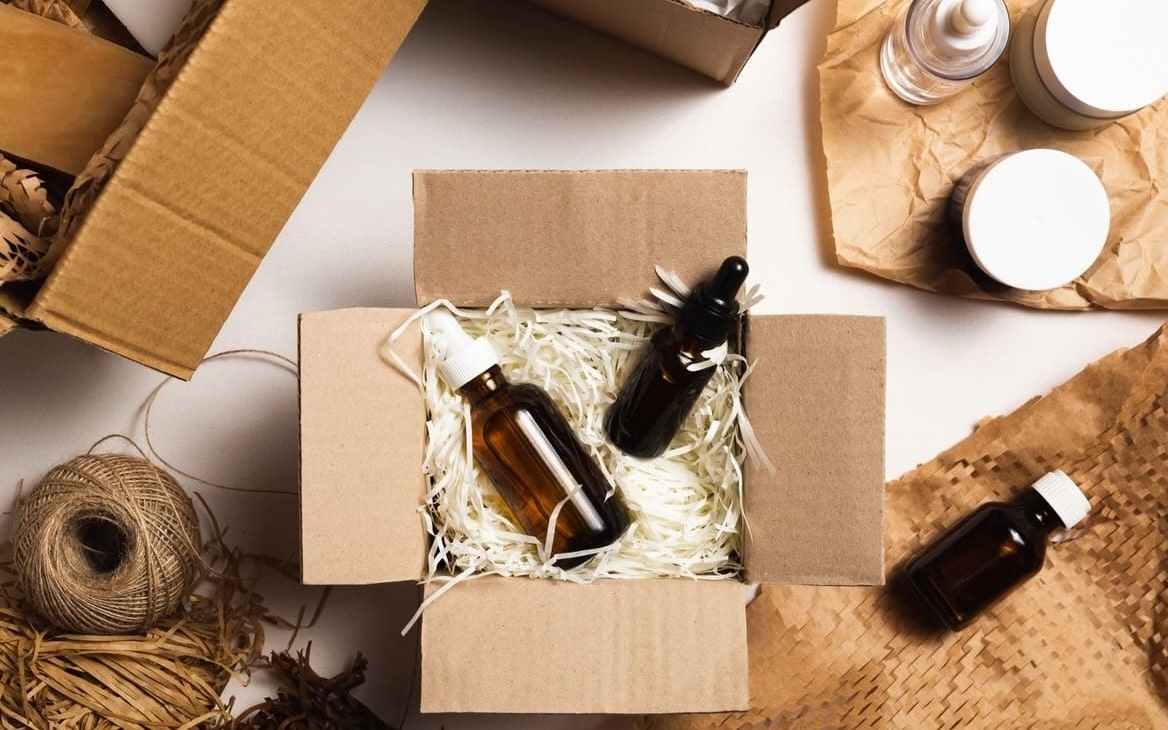
Can You Mail Liquids? Rules and Guidelines Explained
by Jaidyn Farar

Can you send liquids in the mail? Yes! In this guide, we’ll cover carrier guidelines and packaging tips so you can ship beverages, cosmetics, and more with ease.
Can you mail liquids?
Yes, you can mail liquids through carriers like USPS, UPS, and FedEx, as long as containers are tightly sealed and properly packed.
With that said, carriers won’t accept every type of liquid. Liquids that are flammable or dangerous, such as nail polish, gasoline, or alcohol, may be restricted or prohibited.
When shipping a hazardous liquid, you must follow all applicable laws and guidelines. It’s especially important to be aware of these rules when shipping internationally, as each country has its own laws about importing specific types of liquids.
What counts as a liquid?
The USPS defines a liquid as “any substance that flows readily and assumes the form of the container, but retains an independent volume.” Under this definition, creams and pastes are considered liquids.
Sending alcohol through the mail
Individual consumers are not allowed to ship alcoholic beverages. However, licensed businesses may ship alcohol if they follow state regulations and comply with carrier requirements.
While USPS does not transport alcoholic beverages, both FedEx and UPS accept shipments from registered alcohol shippers.
Learn more in this guide: Can You Ship Alcohol for Your Business?
Which carriers mail liquids?
Many carriers mail liquids, including three of the most popular ones in the United States: USPS, UPS, and FedEx.
In this section, we’ll run through some specific guidelines and tips from each carrier. Fortunately, when it comes to packaging non-harmful liquids, the requirements don’t vary much.
For more comprehensive instructions on packaging liquid shipments, see the section below titled “How to send liquids through the mail.”
Shipping liquids with USPS
USPS allows you to mail non-hazardous liquids as long as they don’t give off an “obnoxious odor” that could contaminate other shipments if there’s a leak. If you want to send liquids that are corrosive, explosive, flammable, or toxic, you’ll need to follow the proper hazmat protocols.
USPS provides several packaging guidelines for sending liquids:
- Friction-top closures. Containers with friction-top closures (push-down tops) must be sealed in secure outer packaging. USPS also recommends using locking rings or similar devices to ensure these containers stay sealed.
- Labeling. Packages containing liquids need to be marked externally to show the contents, with arrows showing which side should stay upright.
- Packaging. Non-metal containers larger than four ounces need to be triple-packaged. USPS further specifies that liquids greater than four ounces should be shipped with absorbent material and packed in a durable outer container.
Shipping liquids with UPS
UPS doesn’t say much about their liquid shipping rules, but you’ll be safe as long as you properly package goods and follow all guidelines for transporting hazardous materials. Find more information on restricted and prohibited goods here.
Shipping liquids with FedEx
FedEx’s liquid shipping guidelines are similar to those of USPS and UPS. On their website, they caution that certain liquids may not seem to be hazardous, but can actually be dangerous when transported. These include things like lighter fluid, nail polish, paint, perfume, and solvents. FedEx provides more information about their hazardous materials regulations here.
When it comes to non-hazardous liquids, FedEx recommends thorough packaging procedures to avoid leaks. Let’s look at a few specific recommendations:
- Securing containers. If a container has a screw-on top, friction during transit can cause the top to become loose. To avoid this, secure lids with tape, making an X from the top of the container to the bottom.
- Absorbent material. When leaks or spills happen, you need a backup plan! FedEx suggests packing boxes with “paper towels, cotton balls, cellulose wadding, or moisture-absorbing packets” to soak up any spills.
- Label placement. Writing “This end up” on your package doesn’t guarantee it will be kept at that orientation during transit. Placing your shipping label on the top of the package maximizes the chances that handlers keep it right side up.
Do carriers check packages for liquids?
Generally, carriers don’t open packages to check them for liquids. However, it’s still important to follow proper packaging procedures—and comply with hazmat rules when necessary—to make sure your shipments arrive at their destinations safely.
How to send liquids through the mail
Sending liquids through the mail is similar to shipping other types of packages, but there are a few twists! In this section, we’ll walk through everything you need to know.
1. Follow carrier guidelines and applicable laws
As we’ve already mentioned, carriers have specific guidelines on packaging and labeling, especially for hazardous or flammable liquids. International shipping adds another layer of complexity, as countries may have restrictions on alcohol, chemicals, or even cosmetics.
Failing to follow these rules can lead to delays, fines, or confiscated shipments, so always check with your carrier and research destination country regulations before shipping.
2. Package the liquid securely
Proper packaging helps prevent leaks, spills, and damage during transit. To save money on reshipments (and avoid frustrated customers) follow these steps when preparing liquids for shipping:
- Use leak-proof containers. Before pulling out that cardboard box, take some time to evaluate your product’s direct packaging. Ideally, liquids should be packaged in sturdy, sealed containers.
- Seal containers properly. Use airtight lids, shrink bands, or tape around the cap to prevent leaks. For extra protection, place each container in a sealed plastic bag.
- Use a strong, corrugated box. Choose a durable, corrugated cardboard box that’s large enough to fit cushioning but not so big that products shift around during transit. Avoid poly mailers, which may not offer enough protection.
- Add cushioning and absorbent materials. Place containers upright, wrap each one in bubble wrap or foam padding, and line the box with absorbent materials in case of leaks.
- Secure items. Use dividers and/or pack empty spaces tightly with filler material to prevent movement during transit. Make sure containers aren’t touching each other or the walls of the box.
- Seal the box. Using heavy-duty packing tape, seal both the top and bottom of the package. For extra security, reinforce the seams—this is especially important when shipping heavy items.
3. Add the right labels
Once your package is securely sealed and ready to go, it’s time to add a shipping label! While you can create the label by manually entering shipping data, the most efficient method is to automate the process with label creation technology like EasyPost.
In addition to the standard shipping label, certain shipments may require additional labels to ensure proper handling. Depending on the type of liquid you're shipping, consider adding the following:
- Keep Upright: Helps prevent leaks and spills
- Fragile: Essential for glass containers or other fragile materials
- Hazardous: Required for certain chemicals, flammable liquids, or other regulated substances
- Perishable–Keep Refrigerated: Useful for temperature-sensitive liquids like beverages, cosmetics, or medical products
While there’s no guarantee that delivery workers will notice these extra labels, using them increases the likelihood that your shipment is handled properly, reducing the chances of damage, delays, or compliance issues.
Note: Always check with your carrier for specific labeling requirements, especially when shipping hazardous or perishable liquids.
Tips for mailing liquids internationally
Shipping liquids internationally comes with extra challenges, from customs regulations to carrier restrictions. The tips below will help your packages make it through customs intact.
- Research international laws. Make sure to research the import laws of the destination country, as many places have strict rules about certain liquids. Failing to comply with these rules can result in seized shipments, fines, or costly delays.
- Don’t slack on packaging. International shipments should be packaged just as securely as domestic ones (if not more so). Use leak-proof primary containers, sealed plastic bags, and durable outer packaging to avoid spills.
- Time it right. When shipping time- or temperature-sensitive liquids like cosmetics or food products, remember to factor in longer transit times and potential temperature fluctuations. Choosing an express shipping option and purchasing shipping insurance can help reduce risks.
Things to consider when mailing hazmat liquids
Are the liquids you plan on shipping flammable, corrosive, or toxic? If so, you’ll need to take extra precautions.
Shipping hazardous materials requires strict compliance with carrier regulations and government safety laws.
You’ll need to classify your product under the correct hazardous materials category, use UN-certified packaging, and include proper labels and documentation. You’ll also need to prove that any employees handling and packing these materials are hazmat-certified.
Simplify your shipping with EasyPost
Once your liquids are safely packaged, how can you make sure the rest of the shipping process goes off without a hitch? We recommend automating your shipping with a multi-carrier API like EasyPost. You’ll be able to …
- Save on shipping by integrating with national, regional, and local carriers
- Automatically generate shipping labels from your carrier(s) of choice
- Prevent failed deliveries by validating customer addresses
- Provide seamless, real-time tracking updates
- Include shipping insurance for high-risk packages
- Access AI-powered insights to optimize your shipping
Ready to get started?
Sign up for free or get in touch with the EasyPost team to learn more.